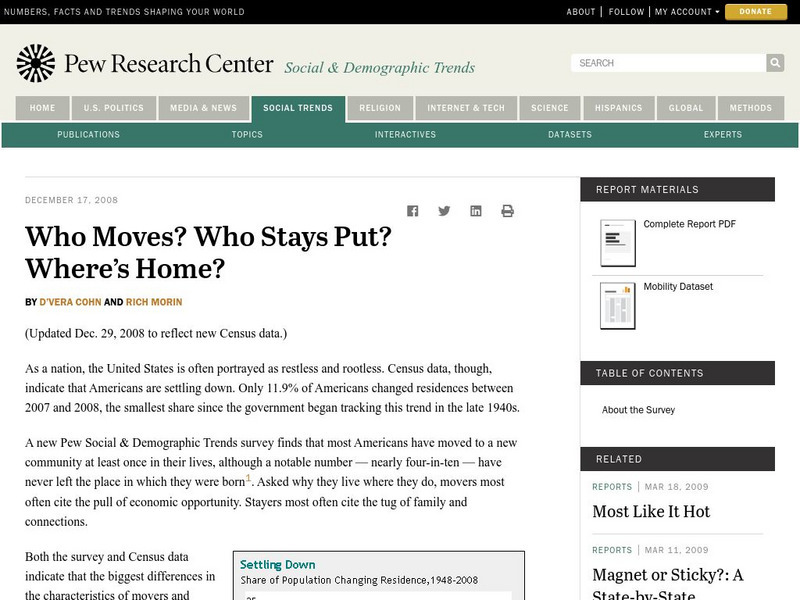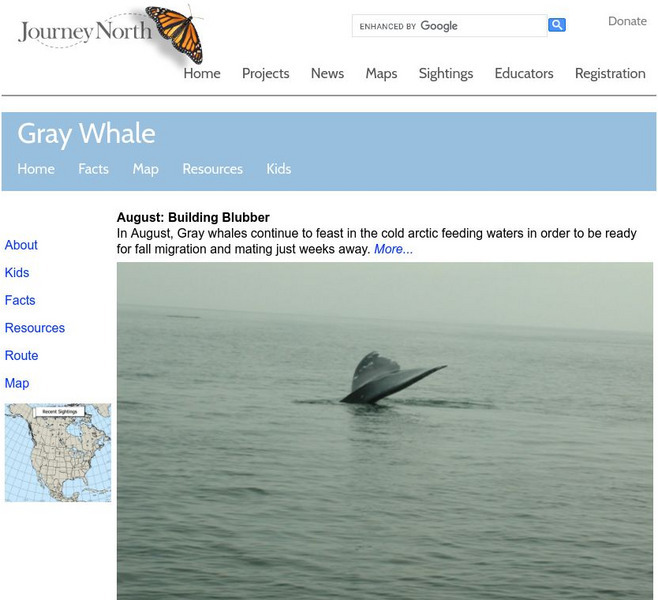New York State Department of Environmental Conservation
Adaptations – Designs for Survival
What's the difference between behavioral adaptations and physical adaptations? Learn about the various ways that organisms adapt to their environment with a worksheet about the creatures of the Hudson River.
Pew Research Center
Pew Social and Demographic Trends: Migration Flows in the United States
The Pew Hispanic Research Center details the migration flows of the United States. Breaks down U.S. migration patterns from the last 20 years. Scroll mouse over map to see the regional migration throughout the years. View a map which...
Annenberg Foundation
Annenberg Learner: Journey North: Caribou
A comprehensive resource that contains facts about caribou, challenge questions, lessons, activities and migration information. The migration pattern of the caribou is also tracked.
Friends of Algonquin Park
The Science Behind Algonquin's Animals: Painted Turtle
Excellent information is provided on the painted turtle's appearance, weight, migration, food sources, predators and breeding. Research questions provide the answers to many common questions such as how long they live.
Annenberg Foundation
Annenberg Learner: Journey North: Gray Whales
Track gray whale migration. Use live data to observe migration patterns.
Annenberg Foundation
Annenberg Learner: Journey North: Report Your Sightings
Observe various migratory species (hummingbirds, butterflies, etc.) and report their sightings online. Share and review the sightings with other students/classrooms to track hemispheric migratory patterns.
Wikimedia
Wikipedia: Canada Goose
This encyclopedia article from Wikipedia defines and describes the Canada goose. Content includes a look at this bird's characteristics, behavior, food, migration pattern, reproduction, and environmental status.
Missouri Botanical Garden
Missouri Botanical Garden: Tundra Animals
Explore this comprehensive resource on the birds and mammals of the tundra. This resource features information such as diet, class, order, size, habitat, conservation range and the like.
Canadian Museum of Nature
Canadian Museum of Nature: Whooping Crane
Briefly described are the Whooping Crane's characteristics, habitat, food and migration patterns. Included are five photographs, including one that illustrates its towering height.
Other
The Evidence for Evolution: Biogeography
These pages are part of a site called "Evolution," that accompanies a textbook by the same name. Mark Ridley is the author. These pages are about the house sparrow and the differences that can be observed in it in different geographical...
USA Today
Minorities Make a Choice to Live With Their Own
Intriguing article explaining the trend illustrated through the 2000 Census information that minorities have broken segregation ties but still choose to live in areas with other members of their racial background.
Countries and Their Cultures
Countries and Their Cultures: Teda
The Teda inhabit the Tibesti Massif, in northern Chad. They are generally considered to be part of a larger grouping of people known as "Tebu," "Tebou," "Tibbu," or "Toubou." Patterns of growth, intraethnic differentiation, and migration...
Other popular searches
- Whale Migration Patterns
- Human Migration Patterns
- Bird Migration Patterns
- Animal Migration Patterns
- Canada Migration Patterns
- Animals Migration Patterns
- Migration Patterns in Us
- Butterfly Migration Patterns
- Global Migration Patterns











